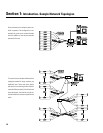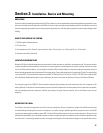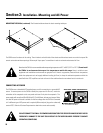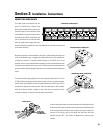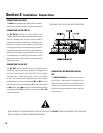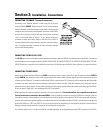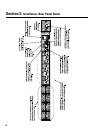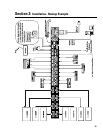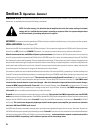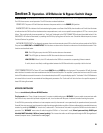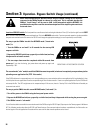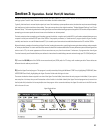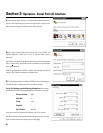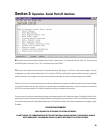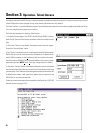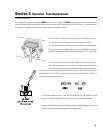
Section 3: Operation- General
AMPLIFIER SETUP-
The amplifiers connected to the CM16a should have their power switches in the ON position and their gain
controls set as required by the user (see
Initial Testing
note below).
NOTE! For initial testing, it is advisable that the amplifiers be set for the lowest useful gain (volume)
setting until it is verified that the system is operating as expected. After the system setup has been
verified and tested, gain settings may be set as required
NETWORK-
The network should be operable and QSControl software should be installed/running on the system controller computer.
CM16a OPERATION- Turn the Power ON!
Operation of the CM16a is accomplished with QSControl software. The only operation required on the CM16a itself is flipping the power
switch from the OFF position to the POWER (ON) position.
It is important to understand the start-up behavior outlined below.
When first taken out the box, the CM16a will power up in a muted state with all faders at -95.5 dB., polarity set to normal, sensitivity
set to 3V, and any amplifiers connected to the CM16a will be in STANDBY mode. This “setup” is the factory setting for Preset #0. The CM16a
has 16 presets for quickly recalling settings. They are numbered 0 (zero) through 15. These presets are useful for quickly changing from one
setup to another without having to change each individual control to a new setting. An example might be in a house of worship where the
audio system setup is different for each service. Instead of having to keep a trained system operator on location, another individual with
minimal training can be shown how to change to the desired preset for each situation.
The presets are useful tools, but Preset #0 acts differently than the others. Each time the CM16a is powered up, it recalls its settings from
Preset #0. The factory Preset #0, discussed above, is a muted state with amps in STANDBY mode. When setting up your own presets, they
should be stored in Preset #1 through Preset #15.
The reason for not actively using Preset #0 is as follows:
Let’s say you’re operating
your system in Preset #12 and you change the setting of one fader. The new setup is NOT the same as Preset #12, so the CM16a starts
a 4 minute timer from the time the control was changed. After the 4 minutes has elapsed with no further control changes,
it saves the NEW scene into Preset #0 . Preset #12 is left unchanged. Whatever
was
in Preset #0 is now gone forever. This insures
that the next time the CM16a is powered up, it’s settings are the same as you left them. Remember, the CM16a always powers up
in Preset #0. Refer to the software documentation for further information.
Preset #0 will only be overwritten 4 minutes after the last control change. This includes if the CM16a is placed into one of its BYPASS
modes as discussed in the following section. If the CM16a is placed into BYPASS mode and operated for at least 4 minutes without control
changes, then the BYPASS mode is saved in Preset #0. The next time the CM16a is powered up, it will start up in Preset #0 (or BYPASS
in this case). This could cause dangerously high output levels from the system. Insure amplifier gain controls are reduced to
safe levels ANY time BYPASS mode is used.
The CM16a has all outputs momentarily muted at power-up to prevent unexpected audio pops, clicks or thumps.
Remember:
At power up,
the CM16a will always start operating with the settings saved in Preset #0. Once network communication has been established between
the host computer and the CM16a, the CM16a may be controlled remotely . In the event that the network communications link is
lost while the CM16a is operating, it will continue to operate with its last settings intact.
24



